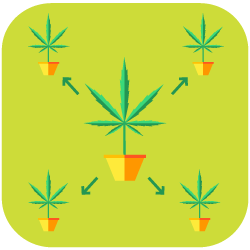Male Vs Female Cannabis: Telling The Difference
Published :
Sep 8, 2016
Categories :
Other subjects

No one wants to spend all the time and effort of growing a few cannabis plants, only to see them produce seeds instead of bud. Learning how to tell the sex of a cannabis plant is key to this.
Cannabis is a dioecious plant. This means that each plant grows with either male or female reproductive organs. Being able to tell the differences between each is fundamental knowledge for the cannabis grower, as preventing pollination of the females is key to growing large, resin-laden bud. When cannabis is pollinated, it undergoes several changes in preparation for seed production that are undesirable when growing for recreational or therapeutic use. When cannabis is not pollinated, the hormonal changes it goes through to try and keep flowers alive for as long as possible are presented to us as much desired psychoactive resins.
SEXING YOUR CANNABIS
 Cannabis will usually give an indication of gender well before going into the proper flower cycle, developing telltale signs within 1-3 weeks of beginning switched to 12-12 lighting. Both sexes begin to show in the same way. Hiding behind the leaf spur where the bud branch meets the trunk a small nodule will appear. As this nodule develops, it takes on different characteristics. If you catch them early on in the flowering cycle, you can determine what you have and ensure males are removed safely before they can alter a crop.
Cannabis will usually give an indication of gender well before going into the proper flower cycle, developing telltale signs within 1-3 weeks of beginning switched to 12-12 lighting. Both sexes begin to show in the same way. Hiding behind the leaf spur where the bud branch meets the trunk a small nodule will appear. As this nodule develops, it takes on different characteristics. If you catch them early on in the flowering cycle, you can determine what you have and ensure males are removed safely before they can alter a crop.
In the male, this protrusion becomes a subtly striped peduncle, like a tiny watermelon. It will develop a lazy thin stalk and hang down, typical of the male organs. These subtle stripes, when developed, become the seams between the sepals where the pod splays open, resembling a small white flower. Dangling from the opened pod are stamens covered in pollen swollen anthers. By this stage, however, pollen is already released, so learning early gender identification is paramount.
In the female, the early nodule subtly unfolds and initially resembles a bent leaf tip. Females have a bract or calyx that is an elongated teardrop shaped gland that is cleft down the middle, typical of the female organ. From this slit unfurls two white or yellow pistils. Commonly called hairs, they are dotted with a clear, sticky resin.
NO MISTAKES WITH CLONING
 The differences between the sexes when growing indoors are not quite as pronounced as with an outdoor grow. A guaranteed way to establish the gender of your babies is to clone each one. Mark the clones and the host plants clearly. Once rooted give them a 12-12 light cycle and wait for nature to take its course. Doing this as early as possible means you can replace the males with more cloned females. If you are mainlining or tipping a good hint is to wait awhile after your first tipping, so enough branch material grows to make two clones as well as giving the second tip. Flower one and veg the other with the rest of your plants. This way you will have replacements for the males if necessary. Your grow won’t be as badly compromised and not have as great a reduction in your end cured yields. Better some smaller girls than none at all!
The differences between the sexes when growing indoors are not quite as pronounced as with an outdoor grow. A guaranteed way to establish the gender of your babies is to clone each one. Mark the clones and the host plants clearly. Once rooted give them a 12-12 light cycle and wait for nature to take its course. Doing this as early as possible means you can replace the males with more cloned females. If you are mainlining or tipping a good hint is to wait awhile after your first tipping, so enough branch material grows to make two clones as well as giving the second tip. Flower one and veg the other with the rest of your plants. This way you will have replacements for the males if necessary. Your grow won’t be as badly compromised and not have as great a reduction in your end cured yields. Better some smaller girls than none at all!
HERMAPHRODITES

Inspecting for male pods should be done throughout the flower cycle just to be sure.
Ensuring you know exactly what your growing is an important part of cannabis cultivation. Learning the early signs of sex will allow you to ensure you get bud every time. There is enough pollen in a single pollen pod to fertilize hundreds of plants. So outdoor growers should be kind and vigilant, not just to preserve their own crop, but other crops kilometres away. No matter your situation, learning to spot and remove males is vital – or you will end up with seeds!






































